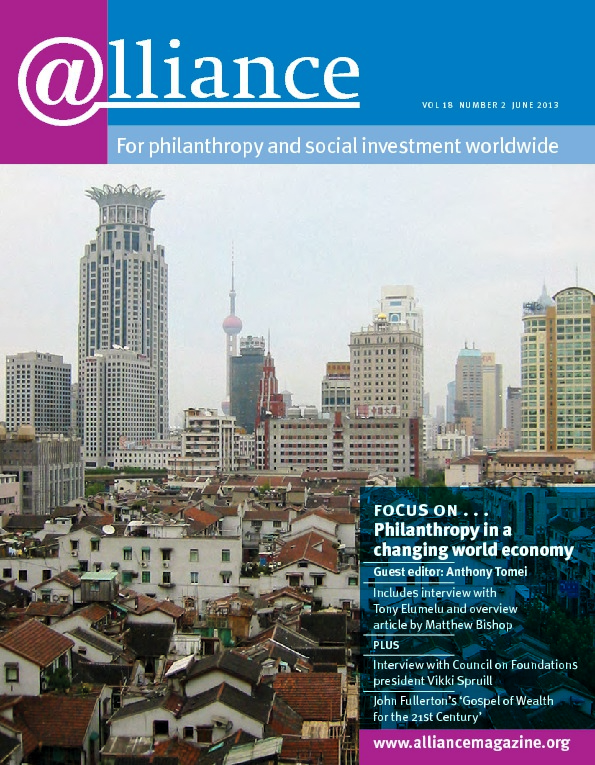Why endowed foundations change is a fascinating but largely neglected puzzle. At one level the puzzle is that they seem to change so little despite the huge social, political and economic changes going on around them. At another level the puzzle is that they change at all. Much organizational theory suggests that organizations change because they have to in order to survive. This doesn’t usually apply to endowed foundations, which enjoy potentially endless life without needing to do anything except satisfy the regulator and invest their assets relatively safely.
A recent collection of essays on US foundations [1] provides an interesting selection of supposed triggers for, and explanations of, ‘accomplished’ change.
Perhaps the most ‘common sense’ but actually relatively rarely presented explanation is that foundations change programme/strategy because ‘the job is done’. The reason for its rarity may be because the job seldom is done (a more likely eventuality is a calculation of diminishing returns) – though in many parts of the foundation world the job has traditionally been seen as pump priming, so in some senses it is always ‘done’ (even if it is not finished) merely by giving a grant.
Another common sense reason for foundation change is fatigue. I found only one example of this in the collection. Steven Wheatley, discussing the early 21st-century Pew and Atlantic withdrawal from higher education funding, suggests: ‘A number of foundations appeared to grow weary of support for education and more hesitant about the assumption that education foundations can deliver on their promise of leveraging philanthropic funding into individual and societal progress’ (p74). So ‘weariness’ here is combined with uncertainty.
Given that foundations are relatively powerless organizations shooting for big goals, it is surprisingly rare for their changing tack to be explained in terms of opposition or inadequate power or influence.
Another common sense explanation is that foundations change in response to changing needs around them. This is clearly sometimes true. The Pilgrim Trust in the UK, for instance, responded to massive unemployment in the 1930s and the Rockefeller Foundation diverted funds into relief for Europe during the First World War. But it is equally striking how little many foundations change even in periods of dramatic external change. As Wolfgang Bielefeld and Jane Chu note, during the 1930s Depression most US foundations did not change focus (p167).
Perhaps one of the most common – and in many ways least satisfactory – anecdotal explanation puts change down to a new CEO or board chair. For example, Daniel Fox, discussing the changing roles and strategies of US health foundations, suggests that in the 1990s leading foundations became important actors in controversial health issues for two reasons: ‘the political experience and knowledge about health affairs of their senior executives and the trustees who hired them and new sources of endowment and other funds’ (p125). Here we have another reason for change suggested: more money. But while less money may fairly obviously trigger new choices, it is not so obvious why more money should trigger change rather than more of the same.
Changing needs and changing structures of provision are closely related to changes in the roles of government – another relatively common explanation of foundation change. At its simplest this sort of explanation says ‘when government enters a field, foundations exit’ (but not vice versa). While there may be some truth in this, it is obviously not a wholly adequate explanation of foundation change, not least because in periods of rapid policy change foundations may become paralysed by uncertainty; staying put may seem a safer option than change.
Perhaps the conclusion is that although foundation change may sometimes have an external source, it is misleading to see it as ‘driven’ by the external environment: external changes have to be perceived and responded to.
This article is very much a work in progress. Understanding the dynamics of foundation change is important for a variety of practical and policy reasons, but to do so will require a move away from simple causal models to more complex explanations in which perceptions, power and negotiation play a part. It is also a project in which foundation archives have a crucial role. Accomplished, publicly visible change is perhaps rare, but through archival study we have a better chance of understanding not only the winning ‘goals’ but also the ‘tries’, ‘passes’ and ‘near misses’.
Diana Leat is an independent consultant. Email dianaleat@hotmail.com
[1] H K Anheier and D Hammack (eds) 2010 American Foundations: Roles and contributions Brookings Institution.



Comments (0)